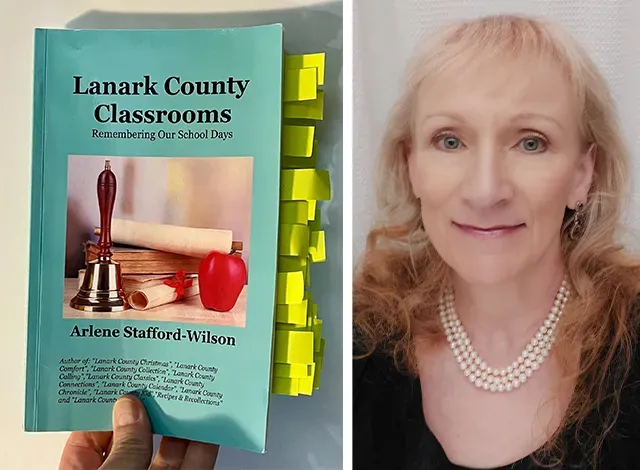Nostalgic reflections of rural Ontario’s one-room schoolhouses by local historian
LAURIE WEIR
For many Baby Boomers who grew up in rural Ontario, the memory of one-room schoolhouses evokes a unique blend of nostalgia and discipline, from the old wood stoves that needed stoking before class began to the blackboards filled with chalk dust, and the dreaded strap for misbehaving students.
In her latest book, Lanark County Classrooms, Remembering Our School Days, local author and historian Arlene Stafford-Wilson captures the essence of this bygone era through a collection of interviews with former students, teachers and custodians.
“I thought it was important to capture those stories as we are among the last generations to attend school before the dawn of technology in the classroom,” she shared with this publication.
One of her earliest memories of school was participating in the “duck and cover drill.” Her teacher blew a whistle and they had to crawl under their desks as quickly as possible.
“Those were the days when Cold War anxiety was not uncommon and the threat of atomic bombs was a frequent theme on the nightly news,” Stafford-Wilson writes in the preface of the book.
She remembers a government-sponsored fitness program, and it was introduced in the schools during the 1967 Centennial celebrations. They were graded on their fitness levels — running and jumping and doing sit-ups. She said their scores must have been off the charts, as they were all local farm kids and that was a way of life.
“Although those first years were spent in one-room schoolhouses with no indoor plumbing, not even a telephone, none of us seemed any worse for the wear,” she writes. “If anything, it toughened us up.”
Wilson’s book paints a vivid picture of school life from the 1940s to the 1970s, when one teacher often juggled the education of eight grades in a single room, each row representing a different class. With class sizes ranging from 12 to 30 children, these small, close-knit communities were united by the shared learning experience in these modest but memorable settings.
Through her interviews, Stafford-Wilson delves into the day-to-day realities of these rural schoolhouses, where the sound of the teacher’s bell marked the start of a day filled with recitations, arithmetic, and scribblers filled with lessons. It was a simpler time, yet one not without its challenges—particularly for the teachers who managed to teach various curriculum needs and adapted to many learning paces.
Shirley Armstrong (Barrie) remembers the long walk to school so she accepted a ride from “two old men in a pickup truck.” This was despite her mother’s warning to never get in a vehicle with strangers.
Stafford-Wilson, known for her ability to bring local history to life, has once again succeeded in preserving the voices of those who experienced these unique educational environments firsthand. The stories shared in Lanark County Classrooms highlight both the trials and the triumphs of rural school life, from the camaraderie among students to the often-strict discipline that left lasting impressions — and welts.
David Bromley recalls getting into trouble for some classroom shenanigans. Ask him about the rubber worm. His teacher made him sit under his desk for the remainder of the class. “I still remember the tears dropping on my brand new two-tone blue suede shoes,” he writes.
One of the more striking aspects of the book is its ability to connect readers with the broader changes in education and community life over the decades. As the population grew and transportation improved, many of these one-room schoolhouses were eventually closed, replaced by larger, more modern facilities. But as Stafford-Wilson’s book clarifies, the lessons learned and the bonds formed in those small classrooms continue to resonate with those who lived it.
In Lanark County Classrooms, Stafford-Wilson not only documents the past but also invites readers to reflect on the broader themes of resilience, community, and the enduring value of education. The book is a testament to the power of memory and storytelling in preserving our collective history.
For those interested in local history, education, or simply a walk down memory lane, Arlene Stafford Wilson’s Lanark County Classrooms offers a richly detailed, heartwarming look at the school days of yesteryear. It’s a reminder of how much has changed—and how much remains the same—in the pursuit of learning.
As readers turn the pages, they may find themselves reminiscing about their own school days, and perhaps even gaining a newfound appreciation for the simplicity and challenges of the one-room schoolhouse era.
Visit https://staffordwilson.com/ to order a copy, or check out the book launch on Saturday, Sept. 21 at The Book Nook, 12 noon to 3 p.m. at 60 Gore St. E. in Perth. Alternatively, you can call 613-267-2350 to reserve a signed copy.




